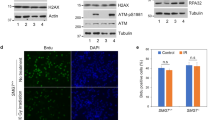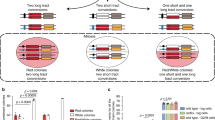Abstract
Genotoxic stress triggers the activation of checkpoints that delay cell-cycle progression to allow for DNA repair1. Studies in fission yeast implicate members of the Rad family of checkpoint proteins, which includes Rad17, Rad1, Rad9 and Hus1, as key early-response elements during the activation of both the DNA damage and replication checkpoints2,3,4,5. Here we demonstrate a direct regulatory linkage between the human Rad17 homologue (hRad17) and the checkpoint kinases, ATM and ATR. Treatment of human cells with genotoxic agents induced ATM/ATR-dependent phosphorylation of hRad17 at Ser 635 and Ser 645. Overexpression of a hRad17 mutant (hRad17AA) bearing Ala substitutions at both phosphorylation sites abrogated the DNA-damage-induced G2 checkpoint, and sensitized human fibroblasts to genotoxic stress. In contrast to wild-type hRad17, the hRad17AA mutant showed no ionizing-radiation-inducible association with hRad1, a component of the hRad1–hRad9–hHus1 checkpoint complex. These findings demonstrate that ATR/ATM-dependent phosphorylation of hRad17 is a critical early event during checkpoint signalling in DNA-damaged cells.
This is a preview of subscription content, access via your institution
Access options
Subscribe to this journal
Receive 51 print issues and online access
$199.00 per year
only $3.90 per issue
Buy this article
- Purchase on Springer Link
- Instant access to full article PDF
Prices may be subject to local taxes which are calculated during checkout





Similar content being viewed by others
References
Zhou, B. B. & Elledge, S. J. The DNA damage response: putting checkpoints in perspective. Nature 408, 433–439 (2000).
O'Connell, M. J., Walworth, N. C. & Carr, A. M. The G2-phase DNA-damage checkpoint. Trends Cell Biol. 10, 296–303 (2000).
Lowndes, N. F. & Murguia, J. R. Sensing and responding to DNA damage. Curr. Opin. Gen. Dev. 10, 17–25 (2000).
Weinert, T. Yeast checkpoint controls and relevance to cancer. Cancer Surveys 29, 109–132 (1997).
Caspari, T. & Carr, A. M. DNA structure checkpoint pathways in Schizosaccharomyces pombe. Biochimie 81, 173–181 (1999).
Venclovas, C. & Thelen, M. P. Structure-based predictions of Rad1, Rad9, Hus1 and Rad17 participation in sliding clamp and clamp-loading complexes. Nucleic Acids Res. 28, 2481–2493 (2000).
Bao, S., Shen, X., Shen, K., Liu, Y. & Wang, X. F. The mammalian Rad24 homologous to yeast Saccharomyces cerevisiae Rad24 and Schizosaccharomyces pombe Rad17 is involved in DNA damage checkpoint. Cell Growth Diff. 9, 961–967 (1998).
Parker, A. E., Van, D. W., Laus, M. C., Verhasselt, P. & Luyten, W. H. M. L. Identification of a human homologue of the Schizosaccharomyces pombe rad17(+) checkpoint gene. J. Biol. Chem. 274, 24438–24439 (1999).
Thelen, M. P., Venclovas, C. & Fidelis, K. A sliding clamp model for the Rad1 family of cell cycle checkpoint proteins. Cell 96, 769–770 (1999).
Rauen, M., Burtelow, M. A., Dufault, V. M. & Karnitz, L. M. The human checkpoint protein hRad17 interacts with the PCNA-like proteins hRad1, hHus1, and hRad9. J. Biol. Chem. 275, 29767–29771 (2000).
Shiloh, Y. ATM and ATR: networking cellular responses to DNA damage. Curr. Opin. Gen. Dev. 11, 71–77 (2001).
Kim, S. T., Lim, D. S., Canman, C. E. & Kastan, M. B. Substrate specificities and identification of putative substrates of ATM kinase family members. J. Biol. Chem. 274, 37538–37543 (1999).
Tibbetts, R. S. et al. A role for ATR in the DNA damage-induced phosphorylation of p53. Genes Dev. 13, 152–157 (1999).
Banin, S. et al. Enhanced phosphorylation of p53 by ATM in response to DNA damage. Science 281, 1674–1677 (1998).
Cliby, W. A. et al. Overexpression of a kinase-inactive ATR protein causes sensitivity to DNA-damaging agents and defects in cell cycle checkpoints. EMBO J. 17, 159–169 (1998).
Tibbetts, R. S. et al. Functional interactions between BRCA1 and the checkpoint kinase ATR during genotoxic stress. Genes Dev. 14, 2989–3002 (2000).
Burtelow, M. A., Kaufmann, S. H. & Karnitz, L. M. Retention of the human Rad9 checkpoint complex in extraction-resistant nuclear complexes after DNA damage. J. Biol. Chem. 275, 26343–26348 (2000).
Sekulic, A. et al. A direct linkage between the phosphoinositide 3-kinase-AKT signaling pathway and the mammalian target of rapamycin in mitogen-stimulated and transformed cells. Cancer Res. 60, 3504–3513 (2000).
He, T. C. et al. A simplified system for generating recombinant adenoviruses. Proc. Natl Acad. Sci. USA 95, 2509–2514 (1998).
Acknowledgements
We thank B. Vogelstein for the pAdTrack-CMV and pAdEasy adenoviral vectors; Y. Xu for the ATM+/+ and ATM-/- mouse embryo fibroblasts; C. Counter for the BJ fibroblasts; L. M. Karnitz for the anti-hRad17 antibody; L. Martinek and M. Cook for the flow cytometric analysis; Y. Yu for technical help; and members of the Wang and Abraham laboratories for scientific discussions. This work was supported by grants from the National Institutes of Health, the A-T Children's Project, and the Johnson and Johnson Foundation.
Author information
Authors and Affiliations
Corresponding author
Rights and permissions
About this article
Cite this article
Bao, S., Tibbetts, R., Brumbaugh, K. et al. ATR/ATM-mediated phosphorylation of human Rad17 is required for genotoxic stress responses. Nature 411, 969–974 (2001). https://doi.org/10.1038/35082110
Received:
Accepted:
Issue Date:
DOI: https://doi.org/10.1038/35082110
This article is cited by
-
Genetic analysis of familial predisposition in the pathogenesis of malignant pleural mesothelioma
Journal of Cancer Research and Clinical Oncology (2023)
-
Critical role of SMG7 in activation of the ATR-CHK1 axis in response to genotoxic stress
Scientific Reports (2021)
-
Profile of Dr. Xiao-Fan Wang
Science China Life Sciences (2020)
-
Characterization of SMG7 14-3-3-like domain reveals phosphoserine binding-independent regulation of p53 and UPF1
Scientific Reports (2019)
-
RAP80 is an independent prognosis biomarker for the outcome of patients with esophageal squamous cell carcinoma
Cell Death & Disease (2018)
Comments
By submitting a comment you agree to abide by our Terms and Community Guidelines. If you find something abusive or that does not comply with our terms or guidelines please flag it as inappropriate.



